Monday, August 17, 2009
Bee Culture Seeks City Beekeepers
If you are a city beekeeper, your time in the limelight may have arrived!
PLEASE NOTE: EMAIL IS CORRECT in the version below:
CATCH THE BUZZ
Help Us Celebrate Urban Bees, and Urban Beekeepers
Bee Culture Magazine and www.thedailygreen.com want to celebrate the incredible explosion of City Beekeepers. We want all urban dwellers with beehives and beesuits, with hive tools and smokers, with supers and covers and frames galore to stand and be counted, to be recognized and noticed. We want everyone that uses five frame, eight frame, ten frame or top bar hives to raise their hands to the sky and shout! We want every and all of America’s backyard, roof top, window box, fire escape, empty lot, and anywhere else in the city honey makers to join the hive and let the world know you’re alive. Let’s get everyone with every hive, in every large or small, crowded or sparse asphalt landscape around the towns and the cities, the suburbs and gardens of America’s everywhere and anywhere to share what they do, show what they grow, and feel pride in their work, their passion and their hobby. It’s no matter if you just started out or are already seasoned in city bees. And if it’s not Kosher to keep bees where you are, we won’t tell, we won’t share because we don’t care…we want the world to know there are thousands who are working to make the bees at home. Thousands who want only the bees, only the peace, only the gentle gift of helping things grow. Thousands who are part of the larger citybee community. Thousands!
If this is you, if this is your time, send us a photo, a gift to share with those who share with you , and especially those who haven't yet but want to. Send a high quality photo, 50 or so well chosen words about your specific, or general location and operation…depending on you and your neighbors and the law of the land where you are. We need contact information so we can get back to you (an email is just fine) if there’s a question so we get it right the first time. Please send all this to Dan Shapley, the Editor and web and guru at thedailygreen.com at Dshapley@hearst.com. He’s a whiz at making all this work. When you send your photos and descriptions, you give The Daily Green and Bee Culture the right to publish the material and share it with its partners. For details, visit www.thedailygreen.com/bee-photos.
It’s time for the bees. Help us show what you do and how you do it. It’s only for those who have, and those who want bees. Join the Community of UrbanBees. Be part of the Revolution. UrbanBees Now!
This message brought to you by Bee Culture, The Magazine Of American Beekeeping
Tuesday, August 04, 2009
DC's Own Girls Are Flying High!
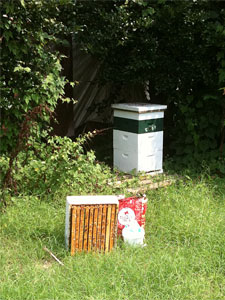 I look after ten hives now, one of which does not belong to me: it's the colony located at the Lederer Youth Garden in NE DC. The hive was started from a package this Spring, and I had a devil of a time getting them going: I donated the bees, equipment and all, a few months ago, so they are officially government honeybees.
I look after ten hives now, one of which does not belong to me: it's the colony located at the Lederer Youth Garden in NE DC. The hive was started from a package this Spring, and I had a devil of a time getting them going: I donated the bees, equipment and all, a few months ago, so they are officially government honeybees. Here's the hive when I arrived today. The medium sitting on it's side is full of recently extracted frames from the roof bees, something I hope will give the girls a head start on additional winter stores. (I guess that means that DC is now the owner of yet another chunk of hive gear!)
My last visit took place on July 8, just before travel. At that time, I checked that the queen was still laying, gave them that green medium super with a few frames of comb, filled the feeder and hoped for the best. Those hopes were truly fufilled!
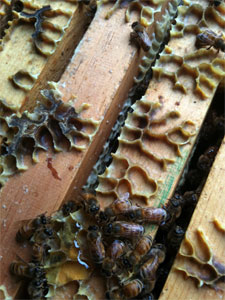 I also brought cappings and honey to put in the feeder, but decided to take a bit of a look inside since so much time had passed.
I also brought cappings and honey to put in the feeder, but decided to take a bit of a look inside since so much time had passed. Here's a confession: even though it had been almost a month since I had even looked at this hive, even though it is a particularly important and privileged colony, it took every bit of self-discipline I had to push forward> You see, it was about 95 degrees F (33 degrees C) by the time I arrived, and I had been stupid enough not to bring any water or socks into which to tuck my jeans!
But the reward was great. Sweet, good-tempered bees were present throughout the top box, and by peeking between the frames I could see that every single one was filled with capped honey. And some drone brood. Hmmm.
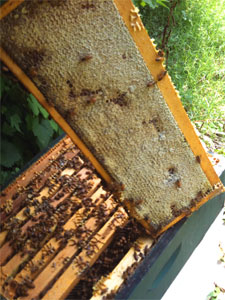 This was the second frame in, even the frame at the edge of the box was completely drawn and filled. Somewhat worrisome: the third frame in had a mass of drone brood, and nothing but drone brood. This was a concern because I have dealt with three unreliable young queens this year, and even though the weather is frying-hot at this time of year, we really have to be thinking about the upcoming winter and whether the queen who is in place will be producing that big batch of fat, healthy cold weather bees we need to take us from October through the end of January (at least).
This was the second frame in, even the frame at the edge of the box was completely drawn and filled. Somewhat worrisome: the third frame in had a mass of drone brood, and nothing but drone brood. This was a concern because I have dealt with three unreliable young queens this year, and even though the weather is frying-hot at this time of year, we really have to be thinking about the upcoming winter and whether the queen who is in place will be producing that big batch of fat, healthy cold weather bees we need to take us from October through the end of January (at least). So once again I had the rare privilege of hefting an 80-pound (about 30 kg) box full of bees and honey gently to its resting place on an inverted telescoping hive cover. Sigh. Luckily, even though it is August, the bees were in no mood to get sting-y and I had enough coordination to keep from squishing anyone.
Also luckily, the first deep frame I pulled from the top brood box was full full full of lovely flat-capped worker brood: mom just laid all those drones in some frame that was warped when I transferred it over before vacation!
So I put back the frame, cleaned up those blobs of honey on top of the whole box (the ones that the girls above are eating) and reserved them to give back, replaced the honey medium, added the extracted box, replaced the hive top feeder, filled it with the blobs I had scraped and several pounds of cappings and honey, and closed up for a while. If I play it right, I can let the girls clean up for about a week, come back to get the now-clean wax (I use it for making soap), and begin the heavy feeding regime that helps keep the hive happy and ready for the season ahead.
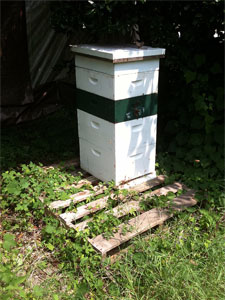 Here's the newly-extended hive! Let's be honest: I've been worried how this season would go–anxious about potyential vandalism, about inadvertent interactions with the public, about being able to make the bees relevant to the whole gardening programme. The first two issues have simply not applied: the bees have a perfect location with the most desired flight path heading right over a field of corn, straight at a tree-lined creek. There are visual barriers and lines of trees and shrubs that keep anyone who is not already looking for the hive from stumbling across it.
Here's the newly-extended hive! Let's be honest: I've been worried how this season would go–anxious about potyential vandalism, about inadvertent interactions with the public, about being able to make the bees relevant to the whole gardening programme. The first two issues have simply not applied: the bees have a perfect location with the most desired flight path heading right over a field of corn, straight at a tree-lined creek. There are visual barriers and lines of trees and shrubs that keep anyone who is not already looking for the hive from stumbling across it. I'd like to do better for the people–especially the kids–who use that garden, and my usual ideas (a soap making seminar, a presentation with an observation hive) are not bad, but they are not really tuned in to the garden's specifics. So there is room for growth there, too.
Monday, July 13, 2009
The Sweetest Harvest: Youth Outreach
 This post is from the road: I am looking for bees in Britain and France again! But there is another reason why the blog suffers in the summertime: it is my best chance to work with children in and about the apiary.
This post is from the road: I am looking for bees in Britain and France again! But there is another reason why the blog suffers in the summertime: it is my best chance to work with children in and about the apiary.I'm a bit over halfway through my presentations, which usually involve bringing an observation hive, an empty hive setup, a skep, some tools and veils, and a honey tasting opportunity. I used to prepare the flow of the presentations a bit more precisely, but usually the kids are more than ready to challenge, ask questions, and generally become friends of the bees with very little help from me.
I work with two dramatically different populations, for the most part, though they all end up being curious kids at heart. My downtown kids usually put me through a bit of an "Are you serious?" drill, where they basically need me to prove two things: that I know what I am talking about, and (more importantly) that this is coming from a place of real caring and passion. They are sick of hearing prescriptions about what they should be doing with their lives, I think, and are primarily interested in whether I am really going to share.
The suburban kids are also skeptical in their own way. They usually have some exposure to the subject matter, and also want to know whether I am wasting their time, in this case with stuff they know already. I am more likely to deal with kids who are actually afraid of nature in the 'burbs: it is an oversimplification, but that folks who have worked so hard to move their kids to the edge of the best have often transmitted a sense of general worry about everything that flies, buzzes, or grows.
But the bees make pretty short work of that. Bring a populated observation hive into a group of kids and you will soon have preteens glued around the box -- and they are usually better at spotting drones than we are.
In our region, summer is the only time I can really do this outreach: by the time schools get rolling in the autumn, the bees are beginning their winter shutdown and are both vulnerable and less cooperative. In the spring, the insects-that-pollinate unit in the curriculum may take place before the weather is safely warm enough to move queens and brood.
But this is an appeal to beekeepers new and established: even after a simple short course, you already know enough to fill an hour-long presentation. And every kid you send home as a friend of bees might be more willing to get his parents to allow bees in a neighbor's back yard, or (later) even their own!
Friday, June 19, 2009
Swarm Catching for Dummies
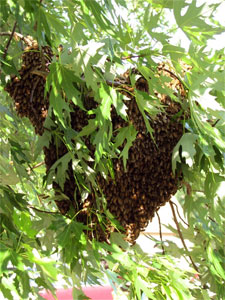 Well into my fifth summer of beekeeping, here's the report: I have become the person about whom I used to scratch my head.
Well into my fifth summer of beekeeping, here's the report: I have become the person about whom I used to scratch my head.Back in 2005, soon after we finished the beginner's "short course," our club sponsored a field day at an orchard apiary in Burtonsville. Just as a coupla dozen students and maybe 6 experienced beekeepers closed up the last hive, a swarm from somewhere else began to settle in one of the trees under which we were standing.
OK, so this is one heck of a coincidence! It was also quite a show.
Before any beginner hive-minders could say, "Um, what?" middle-aged beekeepers sprang into action! Some ran for ladders, some ran for hive parts, one grabbed (I kid you not) a small saw, a 50 foot rope, and a bedsheet from out of his car (just happens to keep them around: don't you?) Another started dinging two pieces of metal together: an old wives' tale says you can get a swarm to settle if you bang pans.
A father of three soon sprang 20-feet-plus up the side of that tree, from which he sawed off a limb with a large swarm on it. Compatriots caught the branch in the sheet, and then set the hive entrance near the swarm. David, the tree climber, was down in a flash, and picked the queen out of that mess of bees and saw her inside. Swarm hived!
Four years and a bit later, I still cannot pick out the queen from a loose mass of bees, but I nonetheless hardly recognize myself. I've caught three swarms this Spring: one mine (*sigh*), one at the White House, and this one.
 I actually object to the title for this post, but it is hard to find a better way to put it. Compared to the story above, the craziest thing about my adventure was a 20-mile trip across metro Washington at rush hour, though the decision was based merely on a non-expert's assessment that a whole lot of bees were hanging out in a convenient bunch right at eye level.
I actually object to the title for this post, but it is hard to find a better way to put it. Compared to the story above, the craziest thing about my adventure was a 20-mile trip across metro Washington at rush hour, though the decision was based merely on a non-expert's assessment that a whole lot of bees were hanging out in a convenient bunch right at eye level.The thing about swarm-catching is that non-beekeepers always say the same few things:
- It's definitely bees;
- There are an enormous number; and
- The safety of the known universe is at stake
The usual case is that it is either yellowjackets, there are only a handful of bees, or they have disappeared by the time you arrive.
In spite of this track record, why did I drive to Reston on June 8 at 5 PM with two sets of bee catching gear (a nuc box for a small swarm, a deep hive body and all the trimmings in case the size was as-billed)? Three more things:
- Karen, the woman who called me, did not seem like the freaky sort, and she had gone to the trouble of calling over to Colvin Run Mill, where my Virginia bees live, to find a beekeeper just because she remembered the apiary there;
- Karen also asked her husband not to call an exterminator before she tried to find a beekeeper in order to give these critters a chance; and
- She swore that the swarm, whatever it's size, was hanging on the lower limb of a really young Maple tree in her front yard, so no ladders, drywall removal, or other shenanigans were required.
The picture of me, above, shows my ungloved hand, near my unveiled head, featuring an uncensored smile, next to a honking huge swarm of bees that somebody out there must sorely miss! I was able to pull my car up within 6 feet of the swarm, which would be considered "shoulder length" if we were all at the hair salon!
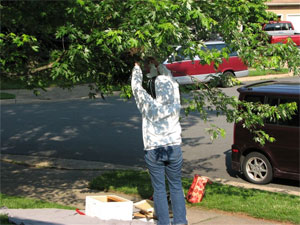 Here you can see the whole set up: there I am with my bed sheet on the ground, my clippers in hand, my hive body at the ready. Yes, I had most of the stuff in the car before Karen even made the call. I was hoping that, since it was after 6 PM by now, that most of the bees had returned from the field. I sat around for a while making sure that everyone was heading into my hive body, but it turns out that another couple thousand bees returned later, and I came back the next day to get them, too.
Here you can see the whole set up: there I am with my bed sheet on the ground, my clippers in hand, my hive body at the ready. Yes, I had most of the stuff in the car before Karen even made the call. I was hoping that, since it was after 6 PM by now, that most of the bees had returned from the field. I sat around for a while making sure that everyone was heading into my hive body, but it turns out that another couple thousand bees returned later, and I came back the next day to get them, too.Because my two new Monastery hives are not doing well, I thought about bringing these bees all the way into the city, but I decided that they belonged out at Colvin Run Mill, all things considered. When I got them there, I peeked inside to be sure all was well, and the bees were already festooning all over the place, beginning to draw comb and make themselves at home. When I brought their laggard sisters the next day, I also brought another hive body and some feeders to help them along with all that wax production.
All in all, I would have done better to leave my capture hive out there that first night, returning back during early early rush hour the next day to ensure that I got more of the bees all at once. I feel sorry for the scouts that got left behind, and hope they managed to wrangle their way back into their home hive, or some other.
And the back of the car in the picture above still houses a small saw, pruners, a bed sheet, and a transportation strap. Just in case, you know?
Wednesday, June 03, 2009
No Such Thing as a Solitary Bee
 Ok, so the truth is that there are lots of solitary bees, but they are not the honeybees that have lived and worked beside people for millennia. Why mention this? Because here in my no-longer-secret hometown, my picture is on the front of an article about beekeeping. I'm glad I'm in a veil, because I would never have had the opportunity to even open a hive without the help and friendship and wisdom of many others, and perhaps a few can be imagined in my place instead.
Ok, so the truth is that there are lots of solitary bees, but they are not the honeybees that have lived and worked beside people for millennia. Why mention this? Because here in my no-longer-secret hometown, my picture is on the front of an article about beekeeping. I'm glad I'm in a veil, because I would never have had the opportunity to even open a hive without the help and friendship and wisdom of many others, and perhaps a few can be imagined in my place instead.Some of them are beekeepers who are ready to tell others all about it, others enjoy a more private relationship with their bees, but it is a rare beekeeper indeed who does not rely on his or her connection to the rest of our community.
I like to tell people new to beekeeping that there is no such thing as a solo honeybee: a bee on its own is simply doomed. The dependencies are deep and complex: all the bees depend on the one indispensable Queen who is their mother, but she is the most helpless bee of all. The workers, who make the whole hive run, have nowhere to live and no food for the future without the existence of thousands of sisters back home who build and clean and guard and feed all day. Those lazy, fuzzy, funny drone boys cannot even feed themselves when their sisters close the doors to them.
And so many of us have opened our lives to them, some of us because we want to connect with our food supply, others to save the bees who are so essential to our agriculture, some for the love of honey, and some for the love of the green world around us.
Whether we planned on it or not, one of the windows that the bees seem always to open looks out on a world of natural miracles and wonder. And worries and responsibilities and joy as we try to help them thrive in a world that seems just packed full of challenges and threats and flowery opportunities.
Newspaper articles appearing now will perhaps make many more thousands of people aware of the bees on my roof and in yards and in flowers all over this city. My own personal hives have never been so exposed, and I hope I have not done wrong by them in sharing them with you. We live in a world that is full of fear, and I can certainly understand why something so unknown and seemingly out of place could cause concern. But we are in so much more danger without ties to the world and each other, without a community to turn to and ties that reach all the way into the world of bugs, plants, and critters.
I cannot tell you how good it feels to have a relationship that links me to a world of flowers and sunshine.
Friday, April 17, 2009
A Visit With the First Bees
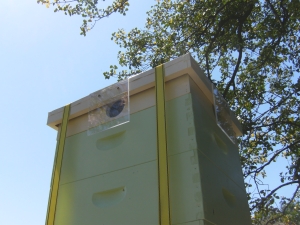 If there is one eternal truth in beekeeping, it's that committed beekeepers always get a bit nervous when someone else inspects their hive, especially if that someone else has kept bees even one week longer. I've got a few years on Charlie, bee-wise, but not that many. Even so, it makes my heart get all warm to see such concerns, because only people who really care have them. And the bees do so much better in the hands of those who care. Which is my way of saying that Charlie let me have a look at the White House honeybees today. Thanks, Charlie!
If there is one eternal truth in beekeeping, it's that committed beekeepers always get a bit nervous when someone else inspects their hive, especially if that someone else has kept bees even one week longer. I've got a few years on Charlie, bee-wise, but not that many. Even so, it makes my heart get all warm to see such concerns, because only people who really care have them. And the bees do so much better in the hands of those who care. Which is my way of saying that Charlie let me have a look at the White House honeybees today. Thanks, Charlie!
Before I go on, this needs to be said: everything touching on that particular place tends to get wrapped up in spotlights and drama, and there is a real danger of feeling self-important or personally special just because of that place and this time. When I share this with you, please keep in mind what this is really about: the bees, and their way of both supporting our environment and inspiring great wonder in those who look after them. I feel that we all owe Charlie a whole lot, and I want him and the Obamas (remember, it's their back yard right now!) and Sam Kass (whose garden project makes it all possible) to get their credit, too.
But I bet you want a look in, too.
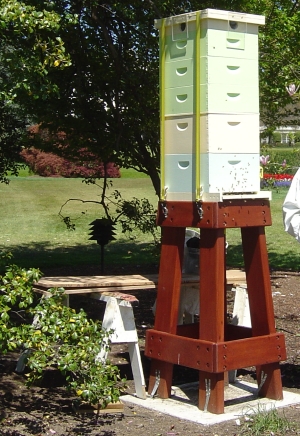 With apologies for the rough crop of the photo, this is how you work the White House bees: on a board set on two sawhorses. It helps to coordinate your movements and to balance anything you are up to with the other person up there! It is a surprisingly stable solution, with the plus that the bees that fall during a manipulation don't end up getting stomped, and you don't have to tuck in your socks to keep them from crawling up a pants leg! The groovy piece of woodenware (the one shielded by some plexiglass near the holes) is a vent of Charlie's own design. The plexi helps moderate high winds, whether natural or from helicopters. One unforeseen benefit of the hive scaffold: it is really easy to look up through the screened bottom board to see where/how tight the bees are clustering.
With apologies for the rough crop of the photo, this is how you work the White House bees: on a board set on two sawhorses. It helps to coordinate your movements and to balance anything you are up to with the other person up there! It is a surprisingly stable solution, with the plus that the bees that fall during a manipulation don't end up getting stomped, and you don't have to tuck in your socks to keep them from crawling up a pants leg! The groovy piece of woodenware (the one shielded by some plexiglass near the holes) is a vent of Charlie's own design. The plexi helps moderate high winds, whether natural or from helicopters. One unforeseen benefit of the hive scaffold: it is really easy to look up through the screened bottom board to see where/how tight the bees are clustering.
As you might imagine, a couple of key concerns for bees in this location are swarm control, and monitoring temperament. Our visit today was mostly around the former: to keep tabs on how they are building up and reverse the hive bodies if that seemed useful, and to make sure there were enough supers in place for the current and soon-to-be-upcoming nectar flow.
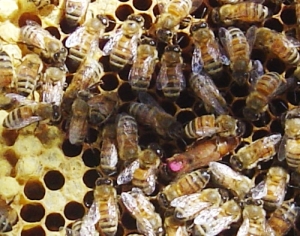 To my mind, Charlie's queen is a good one for the job. The bees were extremely peaceful and gentle, and her pattern was OK, though not gangbusters. In a situation like this, I am all for the happy medium in terms of brood production! The drone brood was in the right place, she seemed to lay more from right to left than in a spiral starting in the center of the frame. You can click that picture of her for a slightly larger version.
To my mind, Charlie's queen is a good one for the job. The bees were extremely peaceful and gentle, and her pattern was OK, though not gangbusters. In a situation like this, I am all for the happy medium in terms of brood production! The drone brood was in the right place, she seemed to lay more from right to left than in a spiral starting in the center of the frame. You can click that picture of her for a slightly larger version.
When we opened some drone brood, there was a minimal presence of varroa. There were no k-wings and I saw no mites on bees. The hive has three medium supers with drawn comb, there is a fair amount of nectar in the first two, so Charlie is out ahead of this one. They had put aside some honey down below, but I am seeing that at home, too. Nice white cappings.
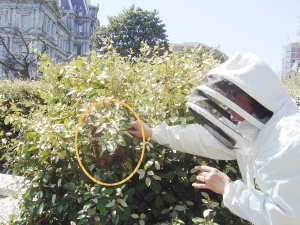 Finally, as I was saying goodbye, Charlie got a call aboutanother swarm at the north gate! I said I would take it if accessible. So we checked it out. It was clearly a second swarm, probably thrown off of the same nearby hive that produced the famous one last week: about 2 pounds (1 kg) of bees (image is clickable for a better view). Since I am giving away a split this weekend, I thought my friend might want this queen to go with it!
Finally, as I was saying goodbye, Charlie got a call aboutanother swarm at the north gate! I said I would take it if accessible. So we checked it out. It was clearly a second swarm, probably thrown off of the same nearby hive that produced the famous one last week: about 2 pounds (1 kg) of bees (image is clickable for a better view). Since I am giving away a split this weekend, I thought my friend might want this queen to go with it!
Charlie got me a box, poked some holes in it with a nail, and we borrowed some bolt cutters from the carpentry shop to lop a small limb off the swarm bush. Sorry bush! He sealed the box shut with blue gaffer's tape, and in a supporting page (a bit later) I will tell you about my hapless adventures in hiving it when I got home.
So once again, thank you for including me in this adventure, for doing such a wonderful thing, and for taking care of those girls the way any one of us would hope our own home hives get tended. I hope you get as much help as you could possibly need in helping them thrive so close to the heart of our nation!
Wednesday, April 15, 2009
Public Beekeeping and Rainy Days
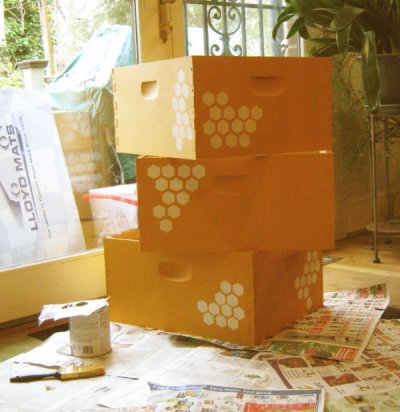 This is the second of two cold, rainy days in a row, and I must finally be catching up because this poor blog is getting some attention. You can see, in this picture, what Spring can bring when the only ways of working for the bees involve paint brushes, newspaper, and a fair amount of cursing.
This is the second of two cold, rainy days in a row, and I must finally be catching up because this poor blog is getting some attention. You can see, in this picture, what Spring can bring when the only ways of working for the bees involve paint brushes, newspaper, and a fair amount of cursing.
Basically, I've got a lot more apiaries to visit this year, though not the one at 1600 Pennsylvania Avenue NW (Charlie might have me over at some point, if some skilled free labor is ever necessary).
This Spring, I've come out as a beekeeper to the Office of the Mayor and to my City Council representative, figuring this is the year to make beekeeping more legally welcome in the city. In response, the District of Columbia has invited me to place hives in two Parks Department-run youth gardens, and USDA has opened some doors at the National Arboretum. Two other beekeepers will take one of the DC gardens, a mentee and one of the staff at the Arboretum will (tentatively) have bees there, and I will cover the other D.C. park. We'll be placing hives and giving presentations to Summer camps. This is in addition to the sessions at Colvin Run Mill, where I am planning to put two new hives from packages.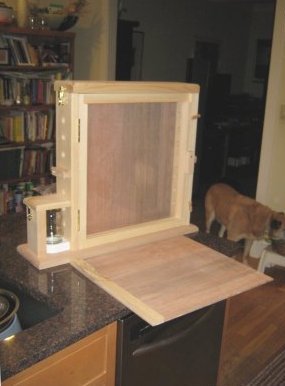
All of this means that there will be lots of summmer camps, at four locations, plus whatever comes up along the way. So I finally bought my own Observation Hive, this one from Betterbee.
The hive bodies you see way above will house the nucs that will begin hives on the roof of the Fairmont Hotel here. Those girls are due on April 23rd.
I was going to get packages for the hotel, too, but my go-to-guy, Larry, ended up with a more successful nuc progam than predicted this Spring, and I thought they offered a better chance for early success, and a partial harvest, which seemed a big goal for the hotel. The chefs at the Fairmont (whom I will be teaching-by-doing) seem a little hesitant all of a sudden, but I am willing to take their bees and this cute-i-fied equipment if they bail out.But let's hope they don't read this blog, right?
My bees have wintered well: I lost just the nuc which was an experiment. Six mature hives survived.It seems to be a trend here to try to winter nucs, and accomplished beekeepers do it, but I'm missing the point, I guess. And missing those lost bees.Three of my hives are monsters that need to be split, and there are three OK ones. I'm giving one split to Joe at the monastery, because he lost some girls this winter and he is a good beekeeper.Everyone has their first supers on, there have been several hive operations this Spring, and I will post more details on a supporting page in a bit. With the order of three nucs and five packages to cover all this, I will have 10 hives in my own apiaries, two in a city park, and four being managed by mentees.
I believe I have lost my mind.This is the year for urban beekeeping, though, and as fearful as I am of taking a public role, there has never been so much public support, interest from new beekeepers, emphasis on "greening" the city, and coverage in the press (even a sidebar on city beekeeping in Scientific American!) I might get shut down, at least downtown, but I have the chance to reach thousands of childrens (and their parents) before that happens, if it happens. My friends in the 'burbs will help me find a place to hide out, if necessary! Please keep my girls in your thoughts as we begin this new phase of adventure.
Please keep all of us, famous, shy, winged, walking, and looking forward to the Sun, in your thoughts as this important season arrives.Sunday, March 29, 2009
An Excellent White House Bee Adventure
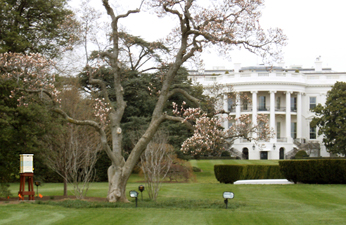 OK folks, I'm not the White House beekeeper, but I got a front row seat at the creation, and am so grateful for the experience that I have to share.
OK folks, I'm not the White House beekeeper, but I got a front row seat at the creation, and am so grateful for the experience that I have to share.And for those of you who just can't wait, I have some additional photos on one of the supporting pages here.
On Tuesday, March 24, the first known hive of bees at the White House arrived at their location on the South Lawn. You don't have to count on my crummy photo to see them: just stop by the fence on the Ellipse (south) side: two deeps and a medium of Maryland mixed breed bees, with known Russian and Caucasian genetics.
The White House beekeeper is Charlie Brandts, someone who has been a quiet beekeeper in this area for three years now. His reserve is probably why he asked me to do some of the talking about his idea to include bees in the White House Victory Garden project.
During the 2008 campaign, Michelle Obama emphasized healthy, local food, and since arriving here has tasked her family's personal chef, Sam Kass, with putting a garden in to supply fresh produce for the Executive Mansion and educational events for the community. Charlie realized that this was a chance to include bees, and to show their important role in putting one of every three bites on your plate. Charlie allocated (free of charge, people!) one of his own hives for the White House Victory Garden, and it will both provide hive products and an teaching opportunities.
Why are you hearing this from me? Even though I am supposed to be a secret beekeeper, I am actually the noisiest hive-minder in Washington. I was invited to meet with the staff, and to tell folks how we get it done in DC! The folks who run the place had some questions about urban beekeeping, but I have spoken to garden clubs who were more resistant to pollination. I think they were just looking for a reason to say "Yes!"
It takes more than ideas, excitement and a presentation to make things happen at such a special place, however. It took a few weeks and approvals from everyone from the First Family to, of course, the lawyers. We've been wanting to tell everyone, and finally, a little while ago, the news broke.
Needless to say, many beekeepers are very excited, and some of them think that Charlie has the responsibility to be some kind of spokesperson for beekeeping in THEIR area. I disagree: he has done his part, it is time for us to do ours.
Now that you know some of the details, it would be great if we would all calm down and use the fact that bees are at the White House to advocate and educate about beekeeping in the wide range of communities and contexts that make up our country.
Don't let this news fade: use this moment to make bees shine in the spotlight, and to tie them to the place where your families live. It is hard for me to imagine a location with more special requirements and available excuses for not including honeybees.
If they can make it there, we can take them anywhere.
Oh yes we can!
Monday, March 02, 2009
Snow Day, Spring, and City Hives on the Rise
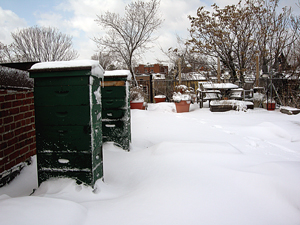 If October marks the end of one yearly cycle of beekeeping in this city, late February and the beginning of March are when we anxiously watch our hives to see if life will return after the trials and tribulations of winter.
If October marks the end of one yearly cycle of beekeeping in this city, late February and the beginning of March are when we anxiously watch our hives to see if life will return after the trials and tribulations of winter.Last week, temperatures hit 70 degrees F (21 degrees Celsius). Today at noon it is 23 degrees F (-5 degrees Celsius). This kind of variation is brutal for the bees.
When it is warmer, they form a rather large, loose cluster over the bottom edge of their honey supply. As it gets colder, that cluster contracts smaller and tighter over a diminishing amount of supplies. They can starve to death if the cold spate lasts a while, because too many bees (who cannot shift) are concentrated too far from where the top edge of the cluster (and the fresh honey supply) used to be. This sort of challenge is what keeps beekeepers biting their nails as our increasingly shifty winters begin to fade.
Local Update
As for my girls, the henbit (Lamium amplexicaule) is out, the willow and maple pollen has started to come in, and the short courses around here will soon be opening their doors, despite all the snow you see above.To recap, six hives and a nuc (nuclear colony) started the winter, and there are still still six hives today. I tried to winter the nuc as an experiment, one many beekeepers around here are doing, and have found it to be a fine way to provide cold-weather homes to white-footed deer mice.
As a last part of my personal report, I wanted to apologize for the quiet on this blog: I've been out with the bees and the beekeepers, and a little ashamed of some of my mistakes.
Spring Brings Newbees
There's a video (from Meerkat Media) embedded below as a flagrant attempt to reach out to newbees, because interest in beekeeping in my city is growing, with at least 8 hives going up on hotels, offices, roofs and back yards. I'll have new neighbors at the monastery, and new beeks to mentor.Just for you curious ones who are wondering if it is possible too have bees on the streets where you live, I know beekeepers in Atlanta and Philadelphia and Baltimore and San Francisco and London who are all on their trajectories toward Spring. The video shows happy beekeepers working in Chicago and New York, as well as more traditional places.
Some renegade beekeepers in Manhattan, The Gotham City Beekeepers, have also asked me for a shout-out and you for your support as they attempt to come out of the shadows and contribute in the sunshine (like the bees).
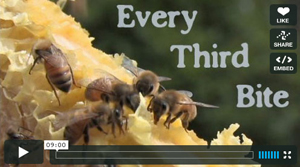
Tuesday, January 13, 2009
Soapmaking Resources
For handouts and links related to soapmaking, please go to
Soap Downloads